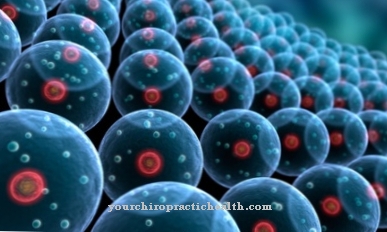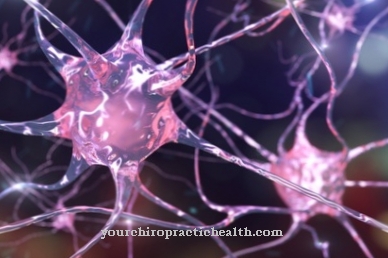The Absolute force results from the maximum strength and the autonomously protected power reserves of the body. The absolute force thus corresponds to the maximum force that a body can theoretically apply against resistance. Illnesses with impairment of the maximum strength also affect the absolute strength.
What is the absolute force?

The neuromuscular system can exert a certain force against resistance. Via the efferent motor nerve tracts, humans give the muscles instructions to contract using commands from the central nervous system. This process can be controlled at will.
The maximum achievable strength of the neuromuscular system under voluntary control corresponds to the so-called maximum strength of a person. This maximum strength depends primarily on the quality of the muscle fibers. However, the maximum strength of a person is not to be understood as the generally highest possible strength output of the neuromuscular system. Rather, this highest possible power output corresponds to the absolute power.
The absolute force consists of an arbitrary maximum force and protected autonomous power reserves, which elude voluntary control. The maximum force is therefore provided deliberately. The absolute force cannot be generated on command, but is subject to autonomous controls and thus protection against consumption. Access to the power reserves protected in this way is only granted in emergency situations, such as fear of death.
Function & task
In emergency situations, people have greater powers than imaginable. Exemplary stories about petite, car-lifting mothers who rescue their own children from emergency situations after an accident are more than just myth. Under certain circumstances, people actually develop unimaginable powers and grow far beyond themselves.
This is made possible thanks to the absolute power of the neuromuscular system or rather thanks to the neuromuscular power reserves that were stored under autonomous protection for "emergencies". The absolute force is therefore a sum of the maximum arbitrary force and the non-arbitrarily retrievable reserves that are subject to independent protection against access. The difference between the practically and arbitrarily available maximum force and the theoretically maximum force that the nerve-muscle system can produce is known as the force deficit.
As long as survival is assured, the body does not release its autonomous power reserves for access. From an evolutionary point of view, this "power bunker behavior" is a common survival principle. In general, every organism saves strength for the sake of survival, where possible. The evolutionary principle of the "easier way", which is preferred by all living beings, also relates to this connection. The background to this principle is the protection against injuries or life-threatening exhaustion.
Since the power reserves of the neuromuscular system are protected from voluntary access under normal circumstances, they are available for survival in life-threatening situations. The reserves can be accessed, for example, under external circumstances such as massive emotional stress in the form of anger or fear of death.
The decisive factor for the absolute force, in addition to the physiological cross-section of the muscles, is its operational capability depending on the nerve stimulation. In emergency and stressful situations, the so-called Leven of Arousal increases in the central nervous system. The body is more receptive to stimuli and the transmission of stimuli to the muscles can also experience an increase. For this reason, with a moderately high level of arousal, the performance of the body is far above average and the power reserves are released.
The hormonal influence of the so-called stress hormones is also relevant for the release. The most important of them: adrenaline, which stimulates the supply of energy.
In addition to emergency situations, the autonomously protected stress reserves can also be called up by external influence with electrical stimulation, hypnosis or performance-enhancing substances.
The strength deficit between voluntary maximum strength and involuntary absolute strength is around 30 percent for a normally trained person. Competitive sports or IK training (intramuscular coordination training) have been shown to reduce the strength deficit by around five percent. On the other hand, the intervention in the evolutionary biological meaningful "power bunker behavior" of the body is not necessarily beneficial.
You can find your medication here
➔ Medicines for muscle weaknessIllnesses & ailments
The maximum strength differs from person to person, for example with the amount of exercise, with the nutritional status and many other factors. Diseases can also limit a person's maximum strength, such as diseases of the contractile elements within the muscles. In this context, for example, structural changes of the myosin based on genetic mutations, as is the case with familial hypertrophic cardiomyopathy, should be mentioned.
Myopathies also limit the voluntary maximum strength. The same applies to a deficiency or defect in actin, a contractile muscle structure protein. In addition, inflammatory diseases of the motor-supplied nerve tissue limit the maximum strength by leaving lesions on the supplying nerves and thus impairing the conductivity of the tissue. This means that contraction commands only reach the muscles to a limited extent or not at all.
The degenerative and neurogenic disease ALS also attacks the central motor neurons and thus gradually paralyzes all muscle movements in the organism. As a consequence, a reduced maximum force also leads to an overall reduced absolute force, since the absolute force is the sum of the maximum force and protected reserves. With muscle paralysis, the maximum strength of these muscles is hardly available.
However, in life-threatening situations there have been reports of paralyzed people who were suddenly able to move again, albeit to a lesser extent. This phenomenon is presumably due to the increased level of arousal, which is in danger to life in the central nervous system and also makes damaged nerve tissue more conducive to stimuli. However, completely destroyed nerve tissue cannot be reactivated even if life is in danger.
Another possible explanation could be the psyche.For example, in the case of demyelinating diseases of the nervous system and the resulting paralysis, a very slight remyelination and thus the recovery of a certain nerve conductivity cannot be completely ruled out. The conviction that they are paralyzed often does not allow the patient to walk in this situation, even if it would be possible to a certain extent. In mortal danger, this psychological phenomenon will probably be overcome.
In addition, previously exercised functions of the defective nerve tissue can be transferred to healthy nerve tissue, which, for example, makes use of physiotherapy after a stroke. A spontaneous transfer of functions in the case of acute danger to life cannot be ruled out from the outset.













.jpg)

.jpg)
.jpg)











.jpg)